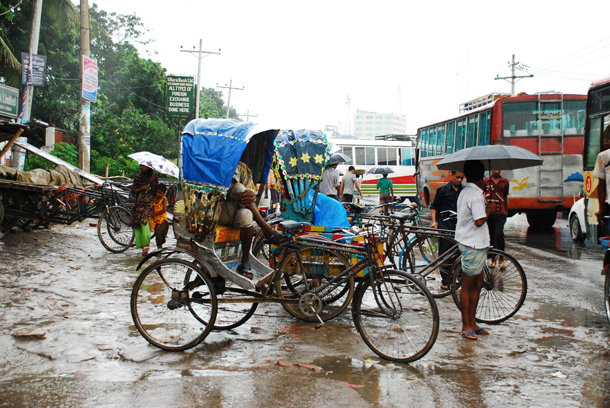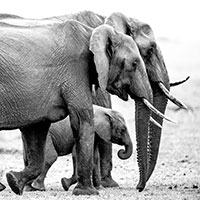The Global Warming Minefield
Air Date: Week of October 20, 2017

Fire-destroyed homes as viewed from a helicopter over Santa Rosa, California. (Photo: The National Guard, Flickr CC BY 2.0)
These times of deadly hurricanes, firestorms and severe drought are linked to global warming, with the prospect of unpleasant surprises ahead. Penn State climate scientist Michael Mann explains to host Steve Curwood that the risk is not so much a single tipping point but rather ‘unknown unknowns’ with the power to disrupt, like a secret minefield. Known dangers include rising sea levels from ice loss and higher energy storms.
Transcript
[THEME]
CURWOOD: From PRI, and the Jennifer and Ted Stanley Studios at the University of Massachusetts Boston, this is Living on Earth. I’m Steve Curwood.
Record breaking Atlantic hurricanes and storms, reaching from Texas to Ireland, along with record firestorms in California linked to record drought raise the question of whether the Earth moved this year into another phase of global warming. And some wonder if climate disruption is slipping into a runaway trajectory that feeds on itself.
Well, for insight, we turn now to leading climate expert Michael Mann at Penn State University. Welcome back to Living On Earth, Michael.
MANN: Thanks, it’s great to be with you.
CURWOOD: So, this season we've seen a rash of all these hurricanes, really intense fires. To what extent, then, do you think we should view these events as our new normal?
MANN: Well, unfortunately, it's worse than a new normal because what we're seeing is the veritable tip of the iceberg, and if we continue on the path that we're on, there's no reason not to expect that we will see even more intense hurricanes and more extreme weather events of the sort we're already starting to see, unprecedented flooding events, unprecedented heat waves and droughts and wildfire, which is a consequence of heat and drought, and if we don't do something about the problem and get our carbon emissions under control, we have every reason to expect that we will see even more devastating and extreme events.
CURWOOD: So, how much is this year an outlier for hurricanes?
MANN: Well, you know, the sort of season we're seeing isn't unprecedented. We saw a similarly active season in 2005, and of course, that gave us Katrina and Wilma and just a number of devastating storms. There are aspects of what we're seeing now, however, that are unprecedented. Irma, for example, was the strongest hurricane as measured by peak sustained winds ever in the open Atlantic. Ophelia, the first category three hurricane to make it as far east as it made it.
One other thing, over the last few years, we have seen record global ocean temperatures, and during that time period we've seen the strongest hurricane on record, that was Hurricane Patricia a couple of years ago in the Pacific. The strongest storm in the northern hemisphere, that was Patricia. The strongest hurricane in the southern hemisphere, that was Winston, and now with Irma, the strongest storm ever in the open Atlantic. It's not a coincidence as these ocean temperatures continue to warm, we are going to see the strongest storms get stronger.
CURWOOD: People worry about tipping points beyond which there is no return, at least in terms of human lifetimes. What of those, if any, have we reached?

As Texans dealt with Hurricane-induced flooding in September, monsoon floods ripped through much of Bangladesh. (Photo: Amir Jina, Flickr CC BY-NC-ND 2.0)
MANN: Yes, this notion that's very widespread that there's some tipping point, that once we warm the planet enough, once we put enough carbon into the atmosphere, we sort of go off this metaphorical cliff. In reality, it's much more subtle than that. There isn't one tipping point. There isn't one cliff that we go off. It's more like we're stepping out onto a minefield, and we don't know exactly where those mines are, but the farther we step out into the minefield, the more we warm the planet, the more likely it is that we do set off these mines, that we do encounter devastating tipping point-like changes in the climate, and I'll just give you one example.
One of those tipping points is the melting of the ice sheets. Once we set in motion the melting of the West Antarctic ice sheet, once we set in play the destruction of the Greenland ice sheet, then we commit to 30 feet, potentially, ultimately of global sea level rise that would be devastating, and one of the things we're learning is that there are other tipping points that might it create. Once we dump a whole lot of fresh water into the North Atlantic, there's the potential to shut down this ocean circulation pattern that we call “The Great Conveyor Belt”. It was popularized in the movie, "The Day After Tomorrow," and while very little of what was portrayed in the movie is likely to happen, if we were to shut down that ocean current that could have a devastating impact on fish populations. You know, the North Atlantic is one of those productive marine environments in the world, and we would lose that productive population of fish that we rely on. There's some emerging evidence that if that ocean circulation pattern were to shut down, you could actually get even more warming in the tropical Atlantic, in the Caribbean, and ironically further intensification of those hurricanes that we've been talking about.
CURWOOD: Now, one thing about the El Niño, the El Niño southern oscillation you guys call this as scientists, is that when it's operating it tends to blow off the top of the hurricanes for the east coast of the US, and you don't get them. So, it would be nice to keep that system going. How we doing in terms of not disrupting the El Niño? I know it's selfish, it's mostly about North America, but hey that's where we live.
MANN: It's a great question and, in fact, El Niño influences not just North America but Africa, Australia, India. It is perhaps the most influential natural climate phenomenon, and it has a profound impact on regional weather patterns. That's going to impact climates in regions around the world, sometimes in very detrimental ways as you allude to. El Niño can sort of be a good thing when it comes to Atlantic hurricanes. El Niño years tend to be years where there's more of what we call “wind shear,” variations in the winds with altitude, and when you have that in the atmosphere, that's adverse to the formation of a hurricane. A hurricane likes to have a nice vertically stacked pattern. So, El Niño is a good thing from that standpoint.
Now, there is a debate within the scientific community, and this is a real debate, it's not a fake debate like, “Is climate change real, or is it human caused?” Those are settled matters. But how will El Niño change because of global warming. That's still a debated proposition, and there is an agreement among the various climate models that scientists use when it comes to what will happen to El Niño. There is some evidence that climate change, counter-intuitively, could actually cause the climate in some ways to look more like the flip side of El Niño, La Niña. La Niña is when the eastern tropical Pacific is actually cooler than usual, and it tends to have the opposite impacts from El Niño. So, La Niña years tend to be dry in the western US, and they tend to be active hurricane years because there's less of that wind shear in the atmosphere.
If climate change, as we've speculated, does lead to a more La Niña-like state of Earth's climate, that could mean that the impacts, when it comes to Western drought, will be worse than the models currently tend to forecast. It could mean that the intensification and increase in activity when it comes to Atlantic hurricanes could be worse than the models currently project. So, it underscores a very important principle here. Yes, there's uncertainty when it comes to some of the details about climate science, but uncertainty is not our friend here, and if it turns out that we are in store for a bit of a surprise, a more La Niña-like future, well, then things would be worse than we currently project.

Citizen Soldiers alongside residents of the municipality of Cayey conduct a route clearing mission after the destruction left by Hurricane Maria through Puerto Rico. (Photo: The National Guard, Flickr CC BY 2.0)
CURWOOD: As of right now, how much in terms of global warming gases is in the atmosphere? Where are we?
MANN: Pre-industrial levels of carbon dioxide were about 280 parts per million. We have now passed about 410 parts per million of CO2 in the atmosphere. That level of CO2 in the atmosphere is unprecedented for millions of years. Now, if you add together all the other greenhouse gases - the methane, nitrous oxide, ozone, which is a pollutant but it's also a greenhouse gas, chlorofluorocarbons, the same molecules that were destroying the ozone layer and were banned, those are also greenhouse gases. If you sort of lump them all together, then the equivalent amount of CO2 is more than 450 parts per million in the atmosphere. But here's the key number. We're at about 410 parts per million actual CO2 in the atmosphere. If we cross about 450 parts per million CO2 in the atmosphere - just CO2 alone - that's where we most likely commit to catastrophic warming of more than two degrees Celsius. And again, there isn't one tipping point. Like I said, it's a minefield, but once we warm the planet more than two degrees Celsius, three-and-a-half Fahrenheit, relative to the pre-industrial, that's when we start to run into the most dangerous mines that are in that minefield.
CURWOOD: Professor Mann, how are we doing in terms of keeping global warming below two degrees centigrade, three-and-a-half degrees Fahrenheit? What needs to change to stay below that threshold, and what do you think of that threshold anyway? How safe would we be?
MANN: Yeah, well, you know, if you're somebody in Bangladesh right now, if you live in the Caribbean islands, if you live in Puerto Rico, if you're a farmer in California, dangerous climate change has already arrived. So, it's somewhat of a fallacy when we talk about dangerous climate change being at the level of two degrees Celsius warming. We've warmed the planet a little more than one degree Celsius, about a degree and a half Fahrenheit thus far, and we're already seeing dangerous impacts on climate. If you live in a low lying Pacific Island, two degrees Celsius warming is way too much. Your home is gone. Your island is gone. So, two degrees is really a number that has been set as more or less a political consensus as to what is viewed as achievable.
So, how are we doing with respect to that challenge? Well, that's where there's a little bit of good news. Global carbon emissions have actually flat lined for the last three years. They haven't grown, even as the global economy has continued to increase. That suggests that we're starting to see this separation between economic growth and carbon emissions, this decoupling of our economy from carbon emissions, and that's attributed to the dramatic growth in renewable energy around the world.
Well, that's not enough. Flat lining our emissions means we continue to put 30 billion tons of carbon into the atmosphere every year. So, as long as we're flat, we're still loading the atmosphere with carbon. We've got to bring those emissions down to zero, and the irony is that if we had acted decades ago when we knew there was a problem, that emissions curve, we would be coming down a bunny slope. Now, instead we've got to come down the black double diamond slope. We've got to bring those emissions down very dramatically, and that's going to take action that goes beyond the commitments of the Paris agreement. At the next major conference of the parties, the participating nations of the world will need to ratchet up their commitments.

Michael Mann is Distinguished Professor of Atmospheric Science at Penn State University. (Photo: Penn State University)
CURWOOD: Michael, in the past you've referred to Mr. Trump's attitude towards "post-truth politics" as really dangerous in terms of our ability to fight climate disruption. How do we avoid some of these difficult scenarios with a president who’s in the process of trying to take us out of Paris and really not acknowledging the risks to our national security, indeed, our survivability from climate disruption?
MANN: Yeah, it's a challenge. There are really a couple things here. First of all, there will be a referendum on the direction that this country has taken under Donald Trump in less than a year, and, you know, if we want enlightened policies when it comes to issues like climate change, we have to elect enlightened politicians. And so, people need to get to the voting booths. If you don't like the direction that things have taken now when it comes to climate change and a host of other issues, you have the ability to express your voice at the voting booth. Ironically, not just the past administration but over the past half century, environmental protections that were put in place by Republican and Democratic presidents alike are currently being dismantled under the current administration, and that's unprecedented.
The carbon reductions that we can expect in the years ahead based on what states and municipalities are doing and based on the trends in the energy market and the rapid increase in renewable energy and electric vehicles, it looks like we will meet our obligations under the Paris Treaty with or without Donald Trump behind it, and so that's good news. Now, the bad news is, just imagine what we could have done given that all that. Just imagine what we could have done if our president had sought to build on the successes of the prior administration rather than try to dismantle them. Some amount of progress inherently will be lost because of the different direction that this administration has taken, and the lack of leadership in Congress to do something, but, again, in less than a year we've got an opportunity to change directions.
CURWOOD: What new research leaves you optimistic about our ability to manage what's coming in terms of climate disruption?
MANN: Well, we've done some research ourselves on what reductions in carbon emissions are necessary to avoid dangerous planetary warming. The good news is that there still is a carbon budget. There's still a certain amount of carbon we can afford to burn and remain below that sort of two degrees Celsius, three-and-a-half dangerous threshold. Dangerous in some generic sense, as we said before, in many places we're already seeing the dangers. But if that's the goal and that seems to be the goal that's been agreed upon by the nations of the world, we can still do it, and our own studies show that there is a path forward.
CURWOOD: Michael Mann is a Distinguished Professor of Atmospheric Science and Director of the Earth Systems Science Center at Penn State University. Thanks so much for taking the time today.
MANN: Thank you, Steve. Always a pleasure.
Links
Common Dreams: “Four Years Ago Puerto Rico Warned of “Climate Tipping Points” – Did Anyone Listen?”
Living on Earth wants to hear from you!
Living on Earth
62 Calef Highway, Suite 212
Lee, NH 03861
Telephone: 617-287-4121
E-mail: comments@loe.org
Newsletter [Click here]
Donate to Living on Earth!
Living on Earth is an independent media program and relies entirely on contributions from listeners and institutions supporting public service. Please donate now to preserve an independent environmental voice.
NewsletterLiving on Earth offers a weekly delivery of the show's rundown to your mailbox. Sign up for our newsletter today!
 Sailors For The Sea: Be the change you want to sea.
Sailors For The Sea: Be the change you want to sea.
 The Grantham Foundation for the Protection of the Environment: Committed to protecting and improving the health of the global environment.
The Grantham Foundation for the Protection of the Environment: Committed to protecting and improving the health of the global environment.
 Contribute to Living on Earth and receive, as our gift to you, an archival print of one of Mark Seth Lender's extraordinary wildlife photographs. Follow the link to see Mark's current collection of photographs.
Contribute to Living on Earth and receive, as our gift to you, an archival print of one of Mark Seth Lender's extraordinary wildlife photographs. Follow the link to see Mark's current collection of photographs.
 Buy a signed copy of Mark Seth Lender's book Smeagull the Seagull & support Living on Earth
Buy a signed copy of Mark Seth Lender's book Smeagull the Seagull & support Living on Earth

